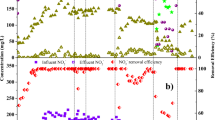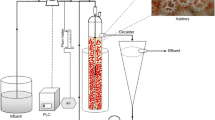Abstract
Cell-specific ammonia oxidation rate (AOR) has been suggested to be an indicator of the performance of nitrification reactors and to be used as an operational parameter previously. However, published AOR values change by orders of magnitude and studies investigating full-scale nitrification reactors are limited. Therefore, this study aimed at quantifying ammonia-oxidizing bacteria (AOB) and estimating their in situ cell-specific AOR in a full-scale activated sludge reactor treating combined domestic and industrial wastewaters. Results showed that cell-specific AOR changed between 5.30 and 9.89 fmol cell−1 h−1, although no significant variation in AOB cell numbers were obtained (1.54E + 08 ± 0.22 cell/ml). However, ammonia-removal efficiency varied largely (52–79 %) and was proportional to the cell-specific AOR in the reactor. This suggested that the cell-specific AOR might be the factor affecting the biological ammonia-removal efficiency of nitrification reactors independent of the AOB number. Further investigation is needed to establish an empirical relationship to use cell-specific AOR as a parameter to operate full-scale nitrification systems more effectively.



Similar content being viewed by others
References
Amann RI, Binder BJ, Olson RJ, Chisholm SW, Devereux R, Stahl DA (1990) Combination of 16S rRNA-targeted oligonucleotide probes with flow cytometry for analyzing mixed microbial populations. Appl Environ Microbiol 56:1919–1925
APHA, AWWA, WPCF (1998) Standard methods for the examination of water and wastewater, 18th edn. American Public Health Association, Washington DC, USA
Bellucci M, Ofiteru ID, Graham WD, Head IM, Curtis TP (2011) Low-dissolved-oxygen nitrifying systems exploit ammonia-oxidizing bacteria with unusually high yields. Appl Environ Microbiol 77(21):7787–7796
Belser LW, Schmidt EL (1980) Growth and oxidation kinetics of three genera of ammonia oxidizing nitrifiers. FEMS Microbiol Lett 7:213–216
Brosius J, Palmer ML, Kennedy PJ, Noller HF (1978) Complete nucleotide sequence of a 16S ribosomal RNA gene from Escherichia coli. Proc Natl Acad Sci U S A 75:4801–4805
Cokgor EU, Karahan O, Orhon D (2008) The effect of mixing pharmaceutical and tannery wastewaters on the biodegradation characteristics of the effluents. J Hazard Mat 156:292–299
Coskuner G, Ballinger SJ, Davenport RJ, Pickering RL, Solera RR, Head IM, Curtis TP (2005) Agreement between theory and measurement in the quantification of ammonia oxidizing bacteria. Appl Environ Microbiol 71(10):6325–6334
Daims H, Bruhl A, Amann R, Schleifer KH, Wagner M (1999) Probe EUB338 is insufficient for the detection of all Bacteria: development and evaluation of a more comprehensive probe set. Syst Appl Microbiol 22:434–444
Daims H, Ramsing NB, Schleifer KH, Wagner M (2001) Cultivation-independent, semiautomatic determination of absolute bacterial cell numbers in environmental samples by fluorescent in situ hybridization. Appl Environ Microbiol 67(12):5810–5818
Daims H, Lücker S, Wagner M (2005) Daime, a novel image analysis program for microbial ecology and biofilm research. Environ Microbiol 8:200–213
Fujita M, Tsuji K, Akashi A (2010) Temporal variation in maximum cell-specific nitrification rate. Water Sci Tech 61(8):2069–2073
Grady CPL, Daigger GT, Lim HC (1999) Biological wastewater treatment, 2nd edn. Marcel Dekker, New York, USA
Harms G, Layton AC, Dionisi HM, Gregory IR, Garrett VM, Hawkins SA, Robinson KG, Sayler GS (2003) Real-time PCR quantification of nitrifying bacteria in a municipal wastewater treatment plant. Environ Sci Technol 37:343–351
Juretschko S, Timmermann G, Schmid M, Schleifer KH, Pommerening-Röser A, Koops HP, Wagner M (1998) Combined molecular and conventional analyses of nitrifying bacterium diversity in activated sludge: Nitrosococcus mobilis and Nitrospira-like bacteria as dominant populations. Appl Environ Microbiol 64:3042–3051
Laanbroek HJ, Gerards S (1993) Competition for limiting amounts of oxygen between Nitrosomonas europaea and Nitrobacter winogradskyi grown in mixed continuous cultures. Arch Microbiol 159:453–459
Limpiyakorn T, Shinohara Y, Kurisu F, Yagi O (2005) Communities of ammonia-oxidizing bacteria in activated sludge of various sewage treatment plants in Tokyo. FEMS Microbiol Ecol 54:205–217
Lydmark P (2006) Population dynamics of nitrifying bacteria in biological wastewater treatment. PhD thesis, Department of Cell and Molecular Biology, Microbiology, Goteborg University, Goteborg
Lydmark P, Almstrand R, Samuelsson K, Mattsson A, Sorensson F, Lindgren PE, Hermansson M (2007) Effects of environmental conditions on the nitrifying population dynamics in a pilot wastewater treatment plant. Environ Microbiol 9(9):2220–2233
Manz W, Amann R, Ludwig W, Wagner M, Schleifer KH (1992) Phylogenetic oligodeoxynucleotide probes for the major subclasses of Proteobacteria: problems and solutions. Syst Appl Microbiol 15:593–600
Mobarry BK, Wagner M, Urbain V, Rittmann B, Stahl D (1996) Phylogenetic probes for analyzing abundance and spatial organization of nitrifying bacteria. Appl Environ Microbiol 62:2156–2162
Park HD, Wells GF, Bae H, Criddle CS, Francis CA (2006) Occurence of ammonia-oxidizing archaeae in wastewater treatment plant bioreactors. Appl Environ Microbiol 72:5643–5647
Purkhold U, Pommerening- Röser A, Juretschko S, Schmid MC, Koops HP, Wagner M (2000) Phylogeny of all recognized species of ammonia oxidizers based on comparative 16S rRNA and amoA sequence analysis: implications for molecular diversity surveys. App Environ Microbiol 66(12):5368–5382
Purkhold U, Wagner M, Timmermann G, Pommerening- Röser A, Koops HP (2003) 16S rRNA and amoA-based phylogeny of 12 novel beta proteobacterial ammonia-oxidizing isolates: extension of the dataset and proposal of a new lineage within the nitrosomonads. Int J Syst Evol Microbiol 53:1485–1494
Rowan AK, Snape JR, Fearnside D, Barer MR, Curtis TP, Head IM (2003) Composition and diversity of ammonia-oxidising bacterial communities in wastewater treatment reactors of different design treating identical wastewater. FEMS Microbiol Ecol 43:195–206
Wagner M, Rath G, Amann RI, Koops HP, Schleifer KH (1995) In situ identification of ammonia-oxidizing bacteria. Syst Appl Microbiol 18:251–264
Acknowledgments
The authors would like to thank the Istanbul Technical University, Dr. Orhan Ocalgiray Molecular Biology-Biotechnology and Genetics Research Center (MOBGAM) for CSLM facility and the treatment plant personnel of Industrial Region, Istanbul for providing the chemical analysis data and help with collecting the samples. The authors also thank two anonymous reviewers for their insightful comments.
Author information
Authors and Affiliations
Corresponding author
Additional information
Responsible editor: Gerald Thouand
Electronic supplementary material
Below is the link to the electronic supplementary material.
Supplementary Table 1
Conventional characterization of the biological treatment influent (Cokgor et al. 2008). (PDF 2462 kb)
Supplementary Fig. 1
Representative FISH images of Eubacteria in red and AOB in magenta (overlay of red and blue) in activated sludge samples obtained by confocal laser scanning microscope. (PDF 30 kb)
Rights and permissions
About this article
Cite this article
Eyice, Ö., Ince, O. & Ince, B.K. Monitoring the abundance and the activity of ammonia-oxidizing bacteria in a full-scale nitrifying activated sludge reactor. Environ Sci Pollut Res 22, 2328–2334 (2015). https://doi.org/10.1007/s11356-014-3519-y
Received:
Accepted:
Published:
Issue Date:
DOI: https://doi.org/10.1007/s11356-014-3519-y




